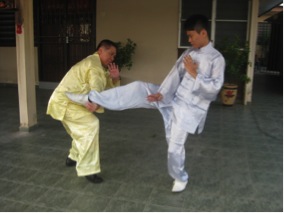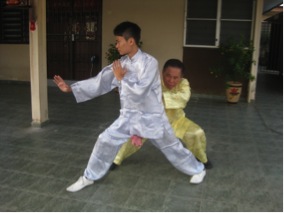QUESTIONS OVER TEA AND MEALS

You lift an opponent's leg with a hook-hand when he executes an organ-seeking kick
Today, our Shaolin Wahnam instructors and some senior students ask very intelligent and rewarding questions. For example, Fleur asked me how I could come up with a strategy after walking only seven steps, Jeffrey asked me the difference in practising Wudang Taijiquan at the physical, the energy and the mind level, and Barry asked me whether I would teach my most cherished set, Dragon Strength.
Can you find any crucial difference between these special questions and other ordinary questions? In answering these special questions, I had to reveal secrets that many masters might not want to reveal, and commit myself what many other masters might not want to commit.
As I have said, I did not have this kind of depth at that time, so I too did not ask my sifu these kinds of questions, though some of the questions I asked brought me unimaginable benefits. Let me recall here, quite randomly, some of the questions I asked my sifu over tea or meals.
“Sifu, do we breathe air into our abdomen when we perform Abdominal Breathing?”
“No, it is not air, it is chi. Chi is some form of electricity. In the past, people did not know of electricity, they called it chi.”
“Sifu, why do we use our index finger when performing One-Finger Shooting Zen?”
“It is to activate the flow of the lung meridian. The lungs are the organs for energy. When the energy flow along the lung meridian is vigorous, internal force is generated.”
“Sifu, how effective is the Crane-Beak in hitting an opponent’s vital points? I can’t think of other useful functions of the Crane-Beak.”
“No, it is not effective in hitting an opponent’s vital points. That is not its function. The Crane-Beak has very specific and limited functions. They are only three functions – to take out an opponent’s eye-ball, to take out his Adam’s apple from the throat, or to snatch his testicle. It is very cruel. We don’t do that.”
“But, just for theoretical knowledge as we won’t do that, how does it work?” I asked.
“This is a secret not many people know. Even masters who have been practising the Crane-Beak for years may not know this secret. An exponent opens his fingers slightly as he jab the fingers into an opponent’s eye, throat or groin. Then he grips the eye-ball, Adam’s apple or testicle and pull it out with his fingers close as in a Crane-Beak.”
My sifu continued, “The Crane-Beak is used in Southern Shaolin, in Hoong Ka. In Northern Shaolin, it is called a Hook-Hand, and the functions are different. Do you know how a Hook-Hand is used in combat?”
“Can sifu enlighten me?”
“The Hook-Hand is excellent in countering a kick, especially an Organ-Seeking Kick (撩阴腿). Retreat slightly to let the kick pass, and simultaneously lift up the kicking leg with a Hook-Hand.”
“Isn’t it better to grip the leg with a Tiger-Claw?” I asked.
“The purpose here is not to grip the leg. It is a preliminary move for the real attack that follows. Move to the back of the opponent, drop the leg and use the same hand to grip the opponent’s groin from behind.”
My sifu then demonstrated the technique to me.
“It’s a fantastic move,” I said. “When I saw such a fantastic technique in pictures, I wondered how an exponent could get to an opponent’s back in time to apply it before the opponent could respond. Now I know.”
“At first, the opponent may wonder how he could escape from his leg being lifted up. When you drop his leg, he would be happy and think that he could escape. But before he realises it, his groin is being gripped, and from behind!” My sifu explained.
Often my sifu’s explanation went far beyond the question asked. Here is another example.
“Sifu, should the fingers be apart or close together when making a hand-sweep, like False Leg Hand-Sweep?”
“The fingers should be close together so as to focus force at the edge of the palm in the hand-sweep. This hand form is called a Willow-Leaf Palm.”
My sifu then showed me the Willow-Leaf Palm (柳叶掌).
“The purpose of False Leg Hand-Sweep is not to block an opponent’s attack as many people mistakenly think,” my sifu continued. “It is to strike an opponent’s attacking arm or leg, at a time even before he can complete his attack! When he thinks he has hit you, he has his arm or leg fractured. This is the tactic of no-defence-direct-counter.”
“No-defence is a misnomer,” my sifu continued to explain. “The defence is retreating into the False Leg Stance. This is an important combat principle called "yien theik lok hung" (引敵落空), which means tricking an opponent to advance to futility. Once you retreat, it doesn’t matter how powerful the attack may be, it is futile as it misses the target.”
At that time, it did not occur to me how useful this combat principle was. As a good student, I just listened to my sifu’s teaching. But later, it turned out to be very useful in my free sparring. Even more importantly, I could apply this principle in daily life, as what many Shaolin Wahnam instructors and students can now do.

You drop you hook-hand to grip his groin from behind
You can read more stories at our Discussion Forum.
Please click here for details to order the special and limited edition. This edition will not be reprinted once it is sold out.
LINKS
